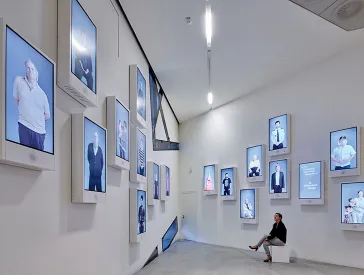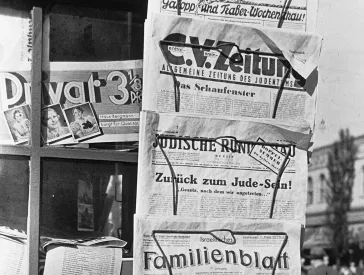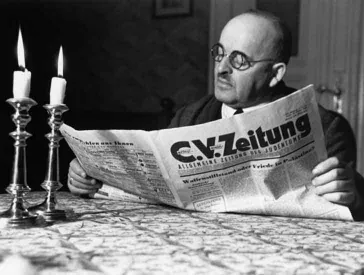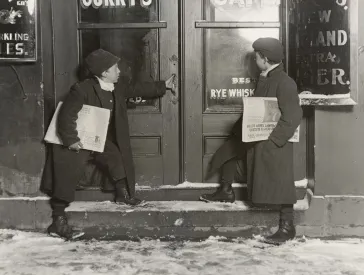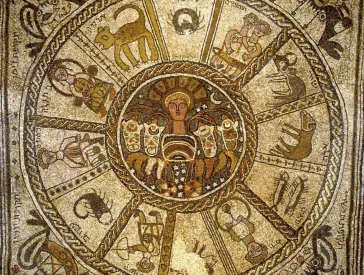The exhibition "A Time for Everything: Rituals Against Forgetting" opens on 18 October 2013
Press Information
Press Release, Thu 17 Oct 2013
On Friday, 18 October, the Jewish Museum Berlin is opening its first major Judaica exhibition "A Time for Everything: Rituals Against Forgetting" (18 October 2013 to 9 February 2014). Its sixteen short chapters are devoted to "rites of passage": On the one hand, existential turning points in life, such as birth, maturity, marriage, and death, are linked to religious tradition. On the other hand, the yearly cycle of Jewish holidays is the basis for presenting the collective dimension of commemoration: Rituals against forgetting, which every generation passes on along with its own historical experiences.
More than sixty selected objects from public and private collections show what is behind both religious and secular commemoration. "What is special about the exhibition is the interplay of sacred and profane times. Using ceremonial and other objects as well as ritual practices, the exhibition examines how historical events impact the holy time of the collective and private festivals and holidays," said Cilly Kugelmann, program director of the Jewish Museum Berlin.
- Contact
-
Press office
T +49 (0)30 259 93 419
presse@jmberlin.de
- Address
Jewish Museum Berlin Foundation
Lindenstraße 9–14
10969 Berlin
Rituals Against Forgetting
The initial impulse for the exhibition came from a quotation from the Jewish wisdom literature: "To every thing there is a season, and a time to every purpose under the heaven. …" (Ecclesiastes 3:1–8). All cultures have rituals that mark the stations in the lives of the individuals and create common ground. Everyone needs rituals against forgetting in order to affirm their culture, religions, history, and identity. "The rituals in Judaism which repeat as a cycle are very important because the events they commemorate are constitutive for religious and cultural Jewish identities. Without a ritualized form of remembrance, the substance of Judaism could be lost," said curator Felicitas Heimann-Jelinek.
The exhibition "A Time for Everything: Rituals Against Forgetting" is devoted to selected periods that are the subject of Jewish memory and the related rites of passage. In illustrating them, individual remembrance strategies are taken up as well as those of significance for the collective. Secular rituals include - for example, in the "Remembering Life" chapter - objects relating to birth, a person’s first rite of passage. In the "Remembering the Fatherland" chapter, Jewish religious objects that demonstrate the loyalty of the European Jews toward their respective country are shown.
Among the collective holidays, the Pesach, or Passover, celebration is introduced under the heading "Remembering Liberation." This annual, identity-building ritual is also popular among secular Jews. The "Remembering the Wandering" chapter treats the seven-day Festival of Booths, Sukkot, which keeps alive the memory of the exodus from Egypt. In remembrance of the temporary dwellings in the desert, Jews build simple booths that they live in each year during the weeklong festival. German rural Jews either built these booths into the attics of their homes, or they set them up before the holiday in their yards. Such a manufactured, portable booth was preserved in Baisingen, a village near Rottenburg on the Neckar River. It was used until 2000 as a chicken coop and was extensively renovated for this exhibition.
"Remembering the Temple"
The Temple in Jerusalem plays a primary, unique role in the history of Jewish thought. The vibrant collective memory of the destruction of the Second Temple in Jerusalem (70 CE) is an essential part of Jewish culture, religion, and identity. This exhibition begins with a projection of the famous mosaic from the late antique synagogue Beit Alfa in Israel. This synagogue symbolizes the development from a sacrificial religious service into one based on the Scriptures. In place of the destroyed Temple came many decentralized synagogues, which each have a Torah scroll, thus becoming a "small holy site."
"Remembering the Word"
Hebrew is the language of the Jewish bible. According to tradition, the five books of the Hebrew bible, the Torah, were dictated to Moses by God on Mount Sinai in the language in which He had already created the world, Hebrew. For a long time, Hebrew was the language of the liturgy. It was not until the early Middle Ages that Hebrew started to be used more and more in daily life.
In addition to objects from school instruction, in this chapter three medieval slate fragments from Cologne are being displayed for the first time: the scribbling, drawings, and writing exercises in Hebrew, early Yiddish, and Middle High German that are displayed here depict everyday school life for children and adolescents in the Jewish community at that time. The three slate tablets are part of a sensational, major find of remnants from the Black Death persecution of Jews in late August 1349.
Quintan Ana Wikswo: "Remembering a Taboo"
Hanging on the walls opposite the traditional Jewish ceremonial objects in all of the exhibition rooms are a total of twenty large-format photographs by the American artist Quintan Ana Wikswo. They deal with a subject that has up to now been neglected by the commemorative rituals of the politics of remembrance: the group of women who were sexually exploited in the concentration camp brothels. The artist approached this taboo subject with a camera and by interviewing women who survived this experience.
In documenting the location of the brothel in the former Dachau concentration camp, Wikswo used cameras with a special history, prepared specifically for this project: The cameras were produced in Dachau by women who did forced labor for the Agfa company. Wikswo put flowers inside the cameras between lens and film, which together with the defective optics of the old cameras produced a special effect. The impression of damage that resulted was intentional and denotes the injuries and suffering of the women forced to work as prostitutes.
Based on the accounts of the women, Wikswo created a lyrical text for each picture. These fragmentary and abstract texts evoke the history of the special blocks. There were brothels for prisoners in several concentration camps. The so-called Sonderbauten were usually torn down after the war. For decades, no sign or plaque marked their existence. Quintan Ana Wikswo’s work questions the taboo that still today surrounds the memory of the specific form of sexual exploitation of women forced to work as prostitutes in the concentration camps.
An exhibition of the Jewish Museum Munich in cooperation with the Jewish Museum Berlin. zittyBerlin is the media partner.
For the exhibition website including a video and further information on the exhibition, go to: www.jmberlin.de/zeit/en.
The richly illustrated catalog offers a survey of selected Jewish rites of passage, their specific forms, and their origins and meaning. (Hardcover, 188 pages, 78 color illustrations, German/ English, Kehrer Verlag, Heidelberg, 36 euros)
A booklet is available for visitors instead of comprehensive object labels.
An audio guide (German/English) is available free of charge. It guides visitors through the sixteen chapters of the exhibition. Texts are spoken by: Felicitas Heimann-Jelinek (curator), Cilly Kugelmann (program director, Jewish Museum Berlin), Michael Wiehen (excavation director, Archaeological Zone, Cologne), Quintan Ana Wikswo (artist), Bill Gross (lender), Inka Bertz (head of collections, Jewish Museum Berlin), Bernhard Purin (director, Jewish Museum Munich). Duration: ca. 60 mins
